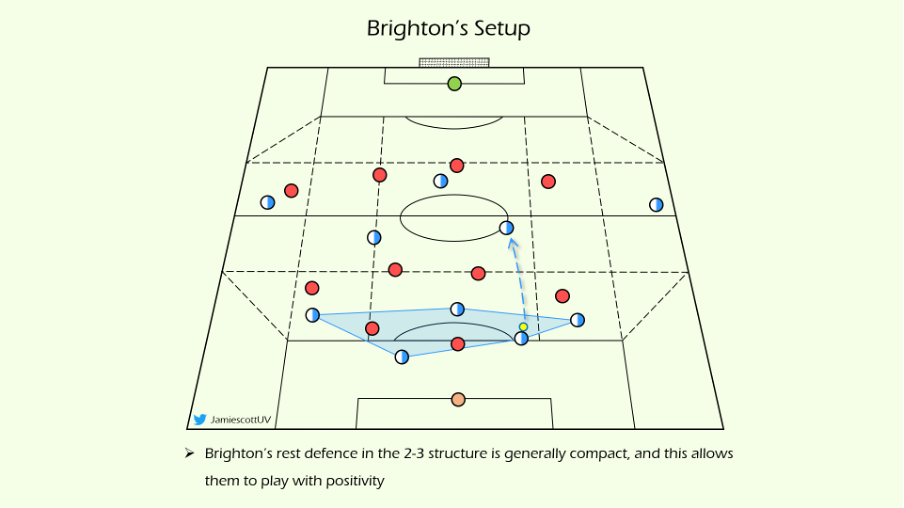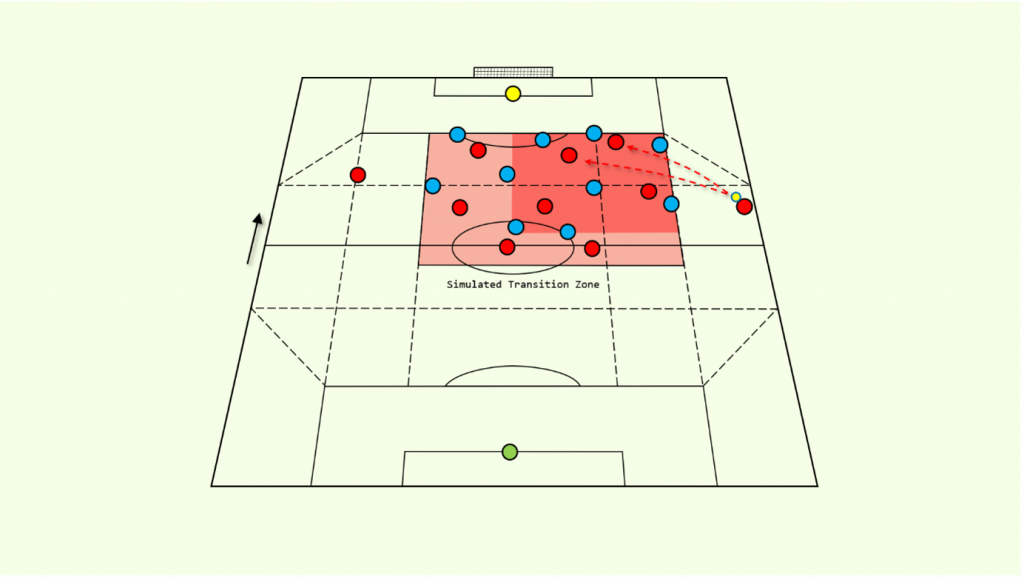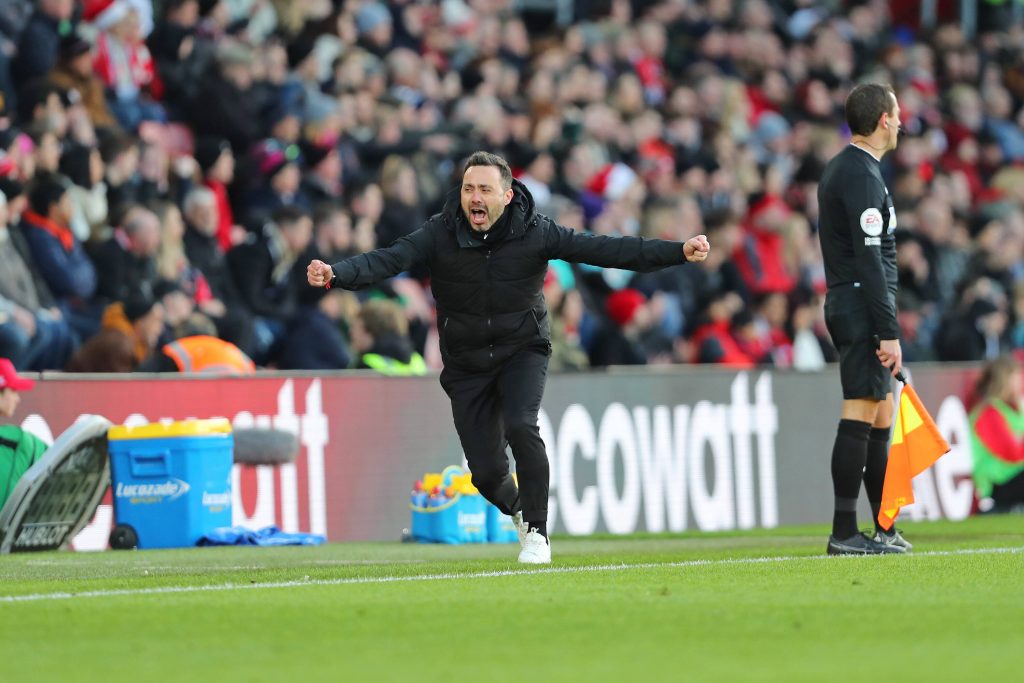Jamie Scott looks at two forms of counter-pressing and what teams do with them
Counter-pressing in football is the act of actively pursuing the ball in a coordinated manner with the aim of regaining possession quickly after ball-loss. The upper bound of time the ball must be won back within varies from coach to coach, and thus in execution by different teams. Generally, the ball must be won back within a number of seconds, or a number of passes, which highlights the urgency a counter-press requires. The reasons for this urgency are fairly obvious: a team can stem a counter-attack ruthlessly by winning the ball back quickly, or they can mount their own attacking assault on the opponent with a swift transition in their favour.
Transitional situations are always dangerous because teams are not organised, but counter-pressing situations are also moments of flux when the team who has recently won possession is in transition to their attacking state; this renders them especially vulnerable and this is what a counter-press seeks to exploit. This article will distinguish the nature defensive and offensive counter-presses, analysing their applications in modern football, before discussing their respective utility on a more holistic level.
Defensive Counter-Press
A defensive counter-press is effectively a means of preventing a situation where your team will face a defensive transition. Defensive transitions are highly dangerous to face for a number of reasons. A team in defensive transition will typically have committed a number of players into attack and will therefore be understaffed in defence. They won’t be settled in an effective defensive block either, due to both the chaos of a transition state, and the fact that teams typically expand their spatial coverage in possession (‘making the pitch big’). Attacking teams will often seek to exploit these weaknesses with a high level of conviction, simply exacerbating the danger of a defensive transition for the side losing the ball.
Perhaps the most pertinent aspect to think about when discussing the implications of defensive transitions, is that the best way to deal with them isn’t to simply avoid them. Yes, it isn’t ideal to lose the ball – not least in dangerous areas – but if a team plays with intent and positivity, ball loss is inevitable at times. Having strong and proactive strategies in place to mitigate the dangers of defensive transitions can help a team achieve a level of stability and safety, while giving their players the freedom to play with positivity, and a modicum of risk, in possession. A defensive counter-press is a facilitator for good football.
One phrase that goes hand in hand with (defensive) counter-press is rest defence. Rest defence can generally be described as a structure the team has in possession, which offers the means for a team to counter-press in an optimal manner when they lose the ball. If the two hallmarks of a good counter-press are speed and success rate of regaining possession, a good rest defence can be the facilitator for these two facets. A typical rest-defence structure is compact, with a number of players surrounding the ball. Because there is an overload of players in a close proximity to the ball, these players only have to travel short distances to initiate an active press, which is conducive to quick possession regain. Additionally, because the players are actively sitting in the positions for a rest defence, they are switched on for a turnover scenario, also allowing them to jump into a press quickly. Finally, the speed of pressure, and the fact that there is an overload of players means that the chance of a successful counter-press is increased: it is harder to play out of the counter-press if a number of players suffocate the player in ball possession immediately.

Roberto De Zerbi and his Brighton side are fast becoming a prominent example for best practice in the modern tactical game and his team have a very strong rest-defence structure in the build-up phase. Regardless of whether Brighton build in the 2-3 shape or the 4-2 shape, they surround the ball carrier with an organised and non-passive structure of players. Their players are primed to make a quick and effective counter-press in the event of ball loss, and this facilitates Brighton’s centre backs’ proclivities to make ambitious, line-breaking passes in build-up. The defensive counter-press isn’t just a fallback strategy in the event of ball loss, but it’s also a means of liberating players who typically wouldn’t have risk taking license with the ball to play more ambitious football.

Pep Guardiola is also a massive advocate of the counter-press. While neither De Zerbi or Guardiola exclusively limit themselves to defensive counter-presses (and this is a discussion point in its own right), Guardiola’s use of the defensive counter-press is also exemplary. Guardiola has long-since cited the reason for inverting his fullbacks as a means of controlling the game, through making shorter, less risky passes in order to keep the ball, and through having a number of players centrally, ready to jump into a defensive counter-press. Guardiola sides are known to deploy this counter-press across most of the pitch; defensive counter-presses are by no means limited to defensive phases, although logically speaking, there is a greater need for defensive counter-presses in zones where your side is likely to be defending more potent attacks.
Furthermore, the lines between an attacking and defensive counter-press do blur to an extent, as they aren’t mutually exclusive in their own rights, and whether a counter-press is defensive or offensive is somewhat implicated by the outcome of the press – for example a press that leads to a shot on goal may be a defensive counter-press by design, but on that occasion may have given rise to an attacking scenario.
Attacking Counter-Press
Attacking counter-presses are harder to define because they are exemplified more by the outcome of the press than defensive counter-presses are. They are also defined more by the zone of the press too: defensive counter-presses can exist in their own rights across the pitch, whereas attacking counter-presses have a high propensity to be in attacking zones (for example in zone 14, around the box, in the final third).
Jurgen Klopp’s Liverpool are a very interesting case study to examine when discussing attacking counter-presses, not least because their team are a great example of this style of counter-press, with Klopp having coached this style of football at the elite level for over ten years now, but also because Liverpool (and previously his Dortmund side) have been so successful with it.
Liverpool don’t initially aim to give the ball away, in order to induce an attacking counter-pressing scenario, but such is the expansive and audacious nature of the football that they play, their high-risk high-reward actions often lead to transition states. Trent Alexander Arnold firing ambitious long balls/crosses into attacking zones is perhaps the epitome of Liverpool’s boldness in progression and creation. These balls often lead to goalscoring chances, and such is Trent’s quality in execution, teams see him as a threat and defend accordingly, already compromising their setup due to a hypothetical scenario. Liverpool’s attacking counter-press facilitates this.

As highlighted in the above graphic, the zones in which Liverpool fire many of their balls into are zones where they can easily initiate a counter-press within. Due to the nature of their setup, which sees them prioritise playing athletic players with a great ability to win second balls, and overloading central areas with inverted wingers and a midfield three, Liverpool are primed to counter-press. Their counter-press seems pre-meditated, and the central zones could quite feasibly be named simulated transition zones: Liverpool lose nothing from losing possession here as they win it back so quickly, and they stand to gain from retaining possession in these dangerous attacking zones; it’s a no-loss scenario. Perhaps what makes the counter-press an attacking one is the fact that this is a pre-meditated strategy. Liverpool prepare for this, and at times, almost rely on winning balls in a chaotic state of transitions and duels, in order to create through the chaos. Liverpool manipulate the factors in their favour to ensure they win their battles, in order for this strategy to be a significant net positive.

Naturally, when Liverpool are out of form, due to injuries or sheer variance, they can see this strategy unravel fairly quickly: their league form in 2020/21 and 2022/23 has been variable at best.
Where the Lines Blur
As mentioned before, an attacking counter-press isn’t necessarily different from a defensive one. In fact, much of the time, these presses don’t even need to be distinguished. Generally speaking, the processes are the same: press, and regain possession. Perhaps distinguishing them by placing the different types of counter-press into two bucket (attacking and defensive) is pure reductive and ignorant, but equally, it can serve as useful when breaking down such complex facets of the game.
Roberto De Zerbi’s Brighton make a mockery of classifying counter-presses as one of defensive or offensive. Or maybe, they simply highlight the notion that counter-presses occur in transition states, and these can serve as both offensive and defensive. Maybe this line of discussion is verging into the realm of semantics, but De Zerbi’s Brighton are certainly an intriguing case study in this topic. They build with either a compact 4-2 or 2-3 structure, and circulate the ball meticulously throughout the build-up phase. They bait pressure, with the perfect microcosm of this baiting being the centrebacks literally putting their foot on the ball until pressure is attracted. The first line of build-up zip passes through the lines in an ambitious, audacious manner. This football may come off, and be highly successful a lot of the time, but execution and form are never perfectly consistent. Ball loss can occur, and that’s the risk that is taken with these in-possession principles. It is therefore integral that their counter-press is functional: they can mitigate a lot of the risk with a strong defensive counter-press. But if the counter-press is a facilitator for their ambitious build-up, and therefore a facet of baiting the pressure, which is where Brighton’s zippy vertical attacking play starts, is the counter-press also an attacking one? This notion gains momentum when considering that Brighton also like to play out of congested areas into space, and capitalise in that manner – no difference between whether that happens in baiting pressure or from losing and regaining the ball in the compact counter-pressing structure they form.
In summary, counter-presses are an integral part of any modern team, and most of the top teams simply must have one to facilitate any positivity and ambition in possession. Some teams deploy counter-presses which are certainly more defensive than others (and vice versa). Whether a counter-press ever reaches a stage where it is entirely defensive, and can be classified as distinct to a counter-press that is entirely attacking by design is debatable. By nature, counter-presses are implemented to either prevent a defensive transition, or induce an attacking transition. This is heavily outcome based, and that clouds the initial intent of the press. If the counter-press is so important, and has such positives for the team, maybe that trying to find the distinction between the two is a moot point anyway.
Header image copyright IMAGO/ColorSport














